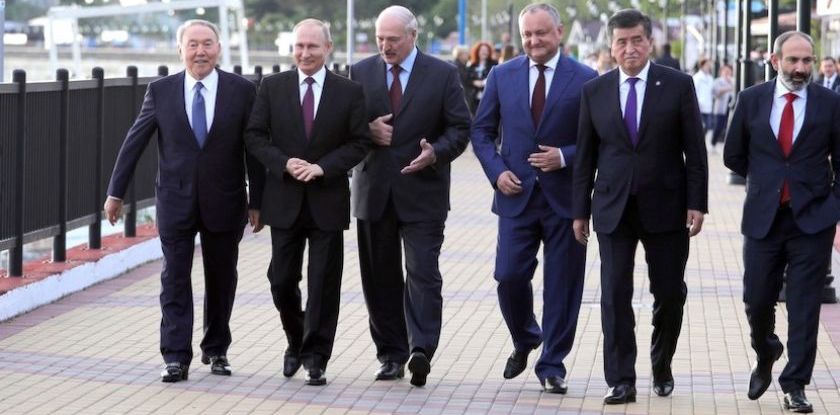The past year, based on official data was quite a successful one in terms of growth (by 26,7%) of mutual goods-exchange between the participant governments of EAEU. And from Jan. 2018, customs code of EAEU came into effect (with some limitations), which is planned to become the next step in deepening of the process of integration. However, we are not yet saying that development of this union is entering a much higher level.
Overall, creation of Eurasian economic Union (EAEU) in the macroeconomic sense is considered justified by all participant states. In the core of the idea are real pragmatic goals, and it can be said that in 2017 it was possible to move towards their achievement.
Participant states of the EAEU gradually started to feel the benefits of partially achieved eased access to their markets, lowering of transit costs, partial freedom of movement of capital, goods and services and work. Barriers that seemed unsurmountable in 2015, related to shock devaluations of national currencies, falling off prices for raw materials exported outside of the borders of the Union, are left behind.
One of the main results of 2017 was the fact of inadequacy of forecasts regarding the harmfulness of Kyrgyzstan’s ascension into the EAEU earlier promoted in the media by its ill-wishers. None of the concerns were justified, regarding:
- Supposedly catastrophic price hikes for goods from third countries in the domestic market of Kyrgyzstan and thus — lowering of the quality of life of its citizens.
- Supposed complete destruction of agriculture in the republic, and thus — desolation of hundreds of thousands of farmers of the new member of EAEU;
- Supposed destruction of Kyrgyz garment industry;
- Losses in profits for the budget of Kyrgyzstan from the collection of customs payments through the common Eurasian «cash register»;
- Threat of the debt pit due to borrowing policy of its EAEU partners; and supposed lack of benefits for the position of Kyrgyz work migrants from entrance into the EAEU.
Thus real results today allow us to convincingly (however not undoubtedly) refute unfavorable forecasts with a concrete factual information.
Dynamic of development of EAEU gradually, though not fast more precisely and positively affects the indicators of national economies of participant-states of the Union. At the level of «protocol talks» consultations are done regarding possible future foreign-policy relations between EAEU and China, India, Iran, Vietnam and Serbia.
However, it is too early to say that development of EAEU enters a whole new higher. Similarly, there are no grounds to hope for further quick and qualitative leap in the trade-economic relations within the Union. Transfer to market relations implemented in member-states of EAEU has birthed a utilitarian-consumerist morality, the highest virtue and criteria of it being financial success and cult of goods and consumption. A model aimed at achieving of short-term interests, took root in all societies of EAEU. Life one day at a time, became a norm.
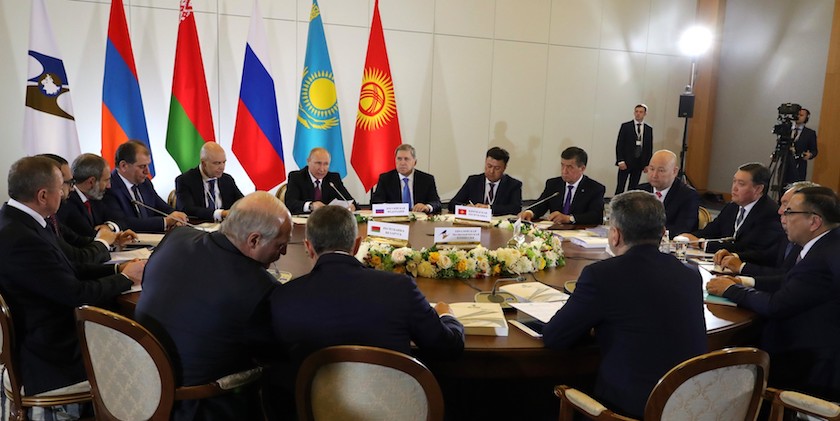
Overall, in the context of modern economic reality, in the conditions of global systemic crisis caused among other things, by discrepancy between the rate of growth of world financial and tangible assets, it is quite naïve to talk of morals. Nonetheless, it was the very lack of sustainable morals lead to the fact that in Russia and in partner-states of EAEU socio-parasitic type of business activity noticeably pushed out its nationally-oriented type. The business activity itself (e.g. entrepreneurship) is interpreted as independent, implemented at one’s own risk, aimed at systemic gain of profits. At the legislative level, a substitution of the essence of entrepreneurship taken place, interpreting it as acquisitiveness, justifying in a practical sense any results and consequences, thus, limiting its socio-economic functions beneficial for society.
Due to this, it is unsurprising that such occurrences as illegal-takeovers, consumer fraud, financial fraud, money manipulation through figureheads and front organizations, became popular forms of «entrepreneurship» in all member-states of EAEU without exception. One shouldn’t be surprised that such methods were transferred to inter-state relations. Thus, dominating in national economies principles of economic Darwinism, within wich, for instance, facts of hostile takeovers are seen as a natural selection in economic life, where there is no place for weak participants, are transferred to relations within the Union. Moreover, it is not join efforts, aimed at common goals, but rather quick and considerable one-sided gain that is the main motivational factor of actions of interacting subjects.
Thus it is appropriate to state, that current achievements of the Eurasian project were mostly achieved thanks to Russian market: Russia served as a sponsor of these achievements, however in practice they didn’t lead to integration of EAEU countries with Russia, but essentially lead to an opposite result. Due to this, unfortunately, economic effect from further removal of barriers, isn’t equal to rising of the level of real integration.
It became apparent that further concession moves on Russian part in the interest of partner-states, in essence make no sense, since further removal of barriers and limits will only create lowering of socio-economic tensions for the elites in their countries (Armenia, Belarus, Kazakhstan and Kyrgyzstan). After which, they sparing themselves the necessity to at least let the Russia side know, start to «offer themselves» outside of EAEU. This practice was going on for years, and its results won’t be taken well.
Whatever proponents or opponents of Eurasian integration in the post-Soviet space might say, in its current state in large part current achievements of EAEU were implemented by taking off of barriers on Russia’s part on the path to trade and movement of labor. Due to this, member-states of EAEU at least temporarily lowered the pressure of socio-economic problems at home. Be it sale of non-marketable goods on global markets or export of labor resources, surplus of which within national borders likely wouldn’t facilitate further prolonging of existing regimes.
If you take away unnecessary arguments about the usefulness of cheap labor force for Russian economy or of Armenian, Belarussian, Kazakhstani or Kyrgyzstani production for a Russian consumer, the first of many questions is: «Do economic indicators of Russia’s EAEU partners line up with results of integration, and what are they»?
Kyrgyzstan. Kyrgyzstan’s membership (which recently survived first in its history peaceful transition of power, since independence in 1991) in the EAEU allows it to preserve socio-economic sustainability in the country, albeit a shaky one. Despite «fears», today due to its membership in EAEU it receives loans from EAEU states, which radically differ from loan terms, provided by China, IMF and other foreign partners. Essentially these grants are for adaptation of economy to conditions of life in EAEU. How will the authorities manage the provided loans — whether they will finance industrialization of economy through loans to local businesses or put the money in their pockets — depends on the authorities.
Based on unofficial data alone, there are at least 125 thousand work migrants from Kyrgyzstan in Kazakshtan, and at least 750 thousand in Russia. Their presence and work conditions, whatever people might say have considerably improved after ascension of Kyrgyzstan into EAEU. In 2017 Kyrgyz migrant workers had to their home-country around 2,5 bil. USD just through official bank transactions, which is equal to around 35% of GDP of Kyrgyzstan. It is unknow how much was remitted unofficially.

It is fair to state also, that because of Kyrgyz membership in EAEU radical changes started in its agricultural production — creation of agricultural holdings, capable of exporting vegetable, meat and dairy products to foreign markets. Naturally, the process, as everywehre comes painfully and with its national nuances due to uniting of small-scale farm enterprises. Did they have a chance to survive, being oriented exclusively towards the domestic market? Possibly, they did, but far from everyone. Just like not everyone has a chance to fit into new conditions. Nonetheless the process is going.
KR’s share of 1.9 percent from the overall volume of customs payments of EAEU in real money equivalent turned out higher, than what it received from its own foreign-economic activity.
Such facts, deflating old «fears» about KR’s membership in EAEU, may be continued.
Kazakhstan. President of Kazakhstan is officially considered the forbearer of the idea of Eurasian integration in the post-Soviet space. Despite the fact that Russia is its de-facto sponsor, the initiative of RF in EAEU isn’t accentuated by the Russian authorities. Thus, Kazakhstan (as well as Belarus, Armenia) received political and economic support of Russia within the framework of Eurasian project.
At the same time, Kazakhstan, calling itself the main «strategic partner» of RF, continues to independently on a bilateral basis, try to establish close cooperation with USA, EU and China.
In that light it is indicative that the content of the renewed agreement on strategic partnership of Kazakhstan and EU not only ideologically contradicts the spirit of EAEU, but already technically impedes a slew of internal procedures within the framework of functioning of higher assembly of EAEU, board of EEC and other formats. As a result real actions of Astana are aimed at not allowing the transformation of EAEU from trade-customs into a full-blown economic Union, not allowing the acquiring by EEC of real functionality as an supra-national regulatory body and sabotaging the idea of creation by 2025 of a single financial market of EAEU.
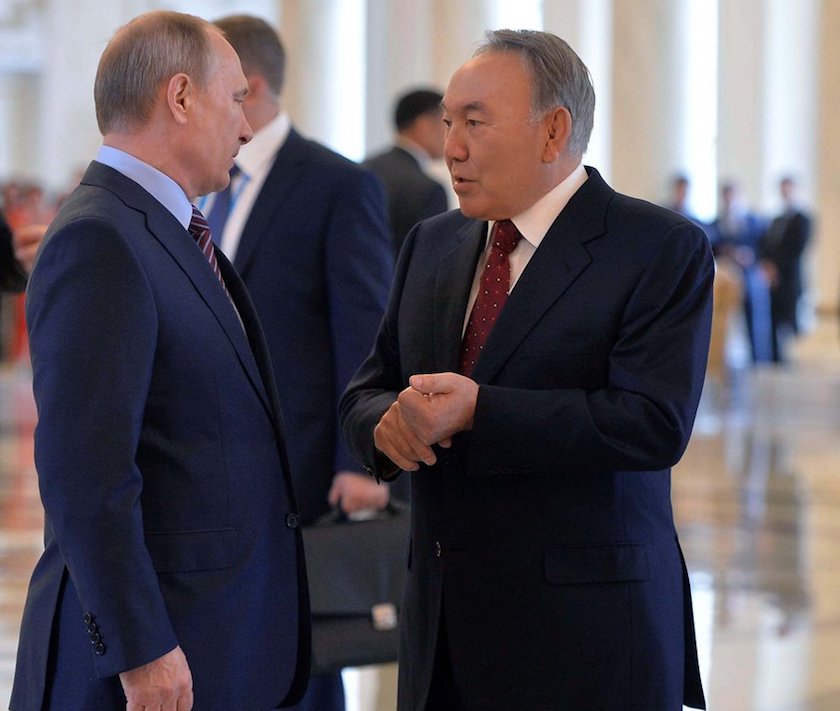
EAEU’s position as a trade-customs union, politically securing safety for Kazakhstani ruling elites and at the same time allowing to conduct the policy of deepening of trade-economic and political relations with China, EU and US, satisfies Astana.
On April 14th Kazakhstan didn’t support the proposed resolution of Russia demanding to condemn the aggression towards Syria and abstained from the vote in the UN security council. To be fair, it must be said that the content of the resolution wasn’t fully drawn out and looked more like a propaganda flyer, and before signing it, it was worth thinking about. However, something else is important: in this backdrop Kazakhstani side tried to offer itself, as a political mediator of regulating of Syrian crisis; seemingly confusing the non-dispute hospitality with real influence on warring groups in Syria.
On April 19th the senate (upper chamber of parliament) of Kazakhstan ratified a protocol, which will allow to use ports of Kurlyk and Aktau in Caspian Sea for transfer of American military cargo into Afghanistan. This isn’t a new subject, and its history officially lasts since 2010 (even much earlier, and the start of the story was in no way related to Afghanistan, but more with preparation for president Nazrbaev to Washington) and is essentially transparent. However, considering USA’s exit from Iran’s nuclear program it gains a different geo-political character.
Of course modern technologies allow to track contents of cargo transferred through Caspian Sea, however it is also evident, that expanding of American military presence on both shores of common sea-lake in current situation is undesirable for some neighbor-states of Kazakhstan, who are also its partners.
However, such hospitality of the founder of Eurasian integration is no news, which in the moment of transit of power and period of barely-sustained stability gives free rein to partner-states of Astana. Bread and salt is of course good, but hopefully the «warm hospitality won’t lead to occurrence of «new Syria» on the map of central Asia — another arena of clashes of players, who ignore that some people still live on this arena.
Armenia. Relations between Armenia and EU the foundation of which was recently renewed with an initialed agreement, is much deeper and more concrete than mutual love between Kazakhstan and Europe. However, their development is constrained by the small scope of Armenian economy. This doesn’t bother EU, since it isn’t Armenian or Kazakhstani economies that are a subject of this agreement. Despite the difference in the texts of both agreements, in their real non-threatening (they way it is phrased officially) for EAEU nature Kazakhstan and Armenia are united by the geo-political importance of their geographic coordinates.
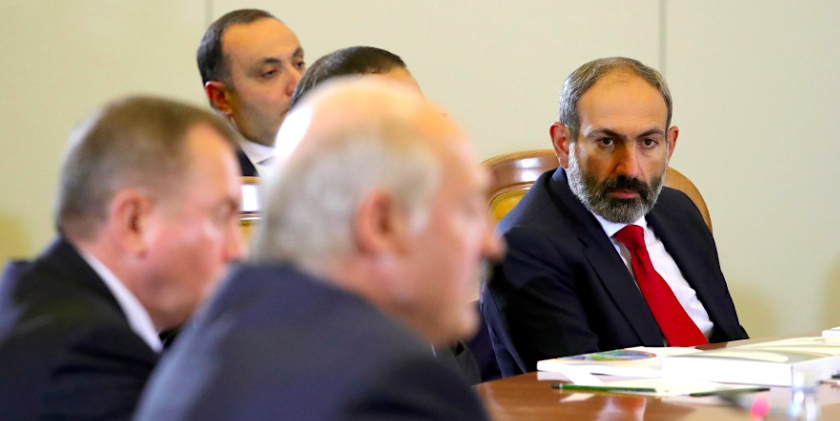
At the same time, room for maneuvers of Armenia, is even more narrow than that of Kazakhstan. Even though the passing by Armenia of such an ideologically harmful for EAEU agreement with EU for speaks for itself — there was no detailed discussion of the contents of this agreement held (though it was necessary) with EAEU partners. Recently resolved domestic crisis in Armenia puts a new prime-minister in a difficult position: in a short time span he has to turn from the moderator of protests into a ruler of a difficult state. One thing is being a leader of «street» politics, another — to make decisions, sitting in the chair of the head of state.
Not just personalities, but also more serious foreign projects (such as prohibited in Russia Islamic movement of Taliban in Afghanistan) have discredited themselves with the lack of skills of running a government, after which they essentially lost their chance for «rebranding».
Belarus. This country requires a separate examination, because it is also a member of «United state». Lukashenko is writing his own version of agreement with the EU, simultaneously with a varying success trying to push «Belarussian» shrimps in the Russian market. In that sense Belarus is no different from other partner states of EAEU — thanks to opening of Russian market of labor and trade, partially solved its socio-economic problems at home and continues to try to sell itself expensively, at least than Ukraine.
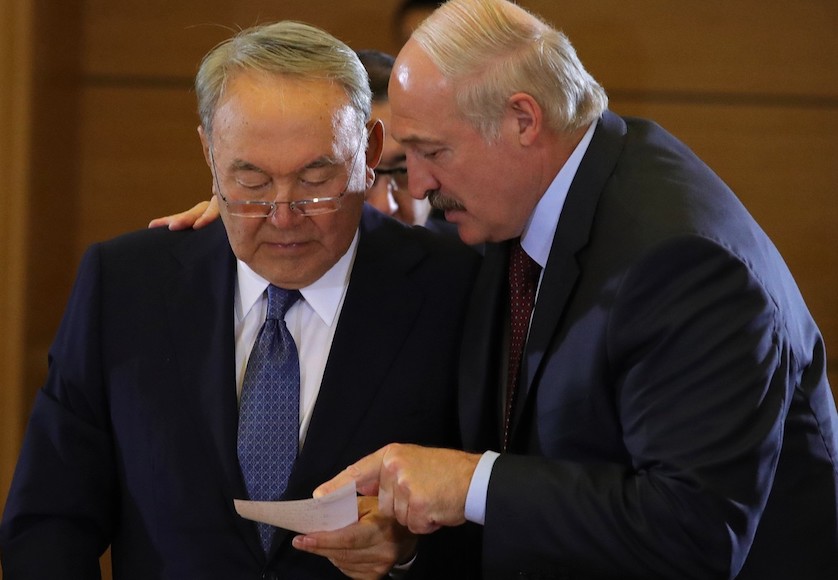
Thus, partnership in the EAEU in the form in which it exists today, eseentially united Armenia, Belarus and Kazakhstan with the group with Georgia, Ukraine and Moldova. Membership in the EAEU through Russia secured the elites of partner-states from socio-economic and political shocks, at the same time giving them free rein in their policy of strengthening of trade-economic and political relations with US, EU countries and China. Further, taking off of barriers is in no way related to real integration, which didn’t happen in reality. Looks like it will start only when refusing the integration will be equal to loss of access to Russian market.
From the Editorial board: the article reflects the view of a Russian political expert.

